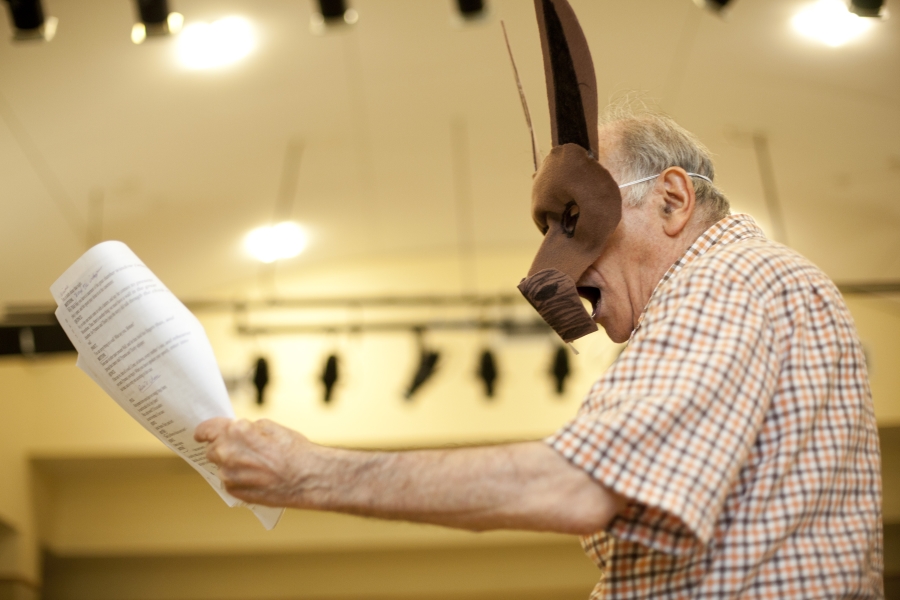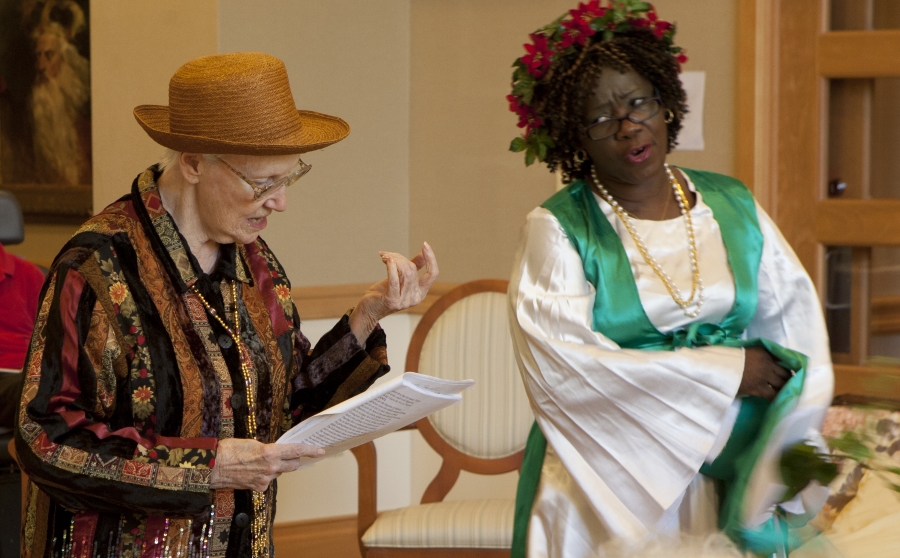The Lillian Booth Actors Home of the Actors Fund in Englewood, N.J., isn’t just an assisted-living facility. It is also a time machine to Broadway’s Golden Age. Operated by the Actors Fund, the residence is home to retired entertainers who once trod Main Stem stages and spent their careers in the limelight and behind the scenes.
Showtunes are frequently heard in the facility halls and scene readings take place in the parlor. In 2011, a film crew helped spur, then document a more sustained effort: the residents’ six-week process of staging A Midsummer Night’s Dream. The result, Still Dreaming, screens on PBS starting April 14 and runs through the month.
Filmmaker Hank Rogerson, whose works include a documentary on performing Shakespeare in prisons, said he wanted to explore a group of elders working with the Bard’s text. “Since it was going to be Shakespeare, I wanted people who had some experience with acting,” says Rogerson of finding the project’s participants.
The Lillian Booth Shakespeare group at the Actors Home, which brings residents together to read scenes, seemed like a perfect place to find his cast. Rogerson then tapped Ben Steinfeld and Noah Brody, co-artistic directors of the New-York based Fiasco Theater, to helm the production. “Ben and Noah’s style through Fiasco really fit this production—minimal props, really working with text, and working with an ensemble,” says Rogerson.

The film’s stars include Joan Stein, a Juilliard-trained concert pianist, who provided accompaniment for the play and played Snout.
Charlotte Fairchild portrayed Puck. In her heyday, Fairchild was Angela Lansbury’s standby for Mame, and appeared in the original Broadway productions of 42nd St, Damn Yankees, All the Girls Came Out to Play, Mr. President and Fiorello. This was her first experience performing Shakespeare.
This was Bob Evans’s first foray with Shakespeare too. Evans danced alongside Fairchild in Damn Yankees, and danced in 13 other original Broadway productions including The Pajama Game and Guys & Dolls.
For others, the project was old hat. Dimos Condos, co-founder of the Lillian Booth Shakespeare group, is a former member of the famed Actors Studio, and his acting credits include performing in Shakespeare’s Richard III.
Rogerson and the Actors Home initially considered mounting Romeo & Juliet, but decided it would be better to work on a comedy with the residents, who face enough tragedy in their daily lives. The ensemble-based comedy of A Midsummer Night’s Dream has a “lightheartedness to it,” says Rogerson, and was a suitable project to work on over the summertime.
Rogerson’s approach to the film started with the idea of homing in on the play’s themes of love. But the love-struck characters weren’t what the actors were drawn to—it was the drug-induced spells and bouts of memory loss they most identified with.
“With this population, it turned from a play that is normally a sex farce about young love, if you will, into a play about perception—a play of dreaming versus reality, because that is what really related to this group,” says Rogerson. “A day-to-day basis, a moment-to-moment basis, whose reality are we dealing with? What was the reality?”
The fantastical comedy, with four interconnecting plots rife with dancing fairies and a chimerical donkey-man, is indeed confusing. The play’s sprawling script, paired with the inherent challenges of working with elders, proved the biggest undertaking. Some productive morning rehearsals were followed by afternoons in which actors forgot which role they were assigned.
“This population of people have a lot of challenges, but showed up every day and gave it what they could,” says Rogerson.
Aideen O’Kelly, who portrayed the character of Quince, used a tape recorder to memorize her lines because her vision is impaired.

So while the project occupied the residents’ time and allowed for them to relive their golden years onstage, it also helped to exercise their memory and boost their social lives. The behind-the-scenes team and film crew also felt changed for the better.
“I learned a wonderful lesson, and it can sound a little clichéd, but what sort of choices are you going to make in your life?” says Rogerson. “What kind of old age are you going to choose? Are you going to choose to keep going, choose to keep creating? Working on your craft, whatever it may be?”
For his part, the project helped to dispel his fears of getting old and gave him a new insight about people suffering from Alzheimers. Joan Stein was reportedly moved when she saw a cut of the finished film before her death in 2016.
“After we showed the film at the Actors Home, she said, ‘It is an affirmation of the power of creativity in our lives.’ It is great to hear your subject say something like that.”


